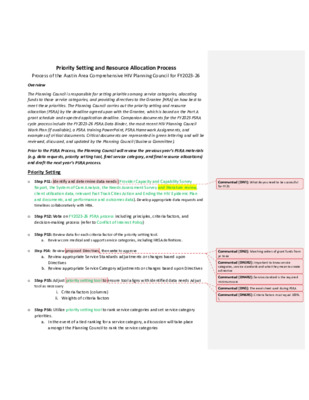Backup — original pdf
Backup

Priority Setting and Resource Allocation Process Process of the Austin Area Comprehensive HIV Planning Council for FY2023‐26 Overview The Planning Council is responsible for setting priorities among service categories, allocating funds to those service categories, and providing directives to the Grantee [HRA] on how best to meet these priorities. The Planning Council carries out the priority setting and resource allocation (PSRA) by the deadline agreed upon with the Grantee, which is based on the Part A grant schedule and expected application deadline. Companion documents for the FY2025 PSRA cycle process include the FY2023‐26 PSRA Data Binder, the most recent HIV Planning Council Work Plan (if available), a PSRA training PowerPoint, PSRA Homework Assignments, and examples of critical documents. Critical documents are represented in green lettering and will be reviewed, discussed, and updated by the Planning Council (Business Committee). Prior to the PSRA Process, the Planning Council will review the previous year’s PSRA materials (e.g. data requests, priority setting tool, final service category, and final resource allocations) and draft the next year’s PSRA process. Priority Setting o Step PS1: Identify and determine data needs (Provider Capacity and Capability Survey Report, the System of Care Analysis, the Needs Assessment Survey and literature review, client utilization data, relevant Fast Track Cities Action and Ending the HIV Epidemic Plan and documents, and performance and outcomes data). Develop appropriate data requests and timelines collaboratively with HRA. o Step PS2: Vote on FY2023‐26 PSRA process including principles, criteria factors, and decision‐making process (refer to Conflict of Interest Policy) o Step PS3: Review data for each criteria factor of the priority setting tool. a. Review core medical and support service categories, including HRSA definitions. o Step PS4: Review proposed Directives, then vote to approve a. Review appropriate Service Standards adjustments or changes based upon b. Review appropriate Service Category adjustments or changes based upon Directives Directives o Step PS5: Adjust priority setting tool to ensure tool aligns with identified data needs Adjust tool as necessary i. Criteria factors (columns) ii. Weights of criteria factors priorities. o Step PS6: Utilize priority setting tool to rank service categories and set service category a. In the event of a tied ranking for a service category, a discussion will take place amongst the Planning Council to rank the service categories Commented [DN1]: What do you need to be successful for FY25 Commented [DN2]: Marching orders of grant funds from pc to aa Commented [DN3R2]: Important to know service categories, service standards and what they mean to create a directive Commented [DN4R2]: Service standard is the required minimum care Commented [DN5]: The excel sheet used during PSRA Commented [DN6R5]: Criteria factors must equal 100% \ o Step PS7: Vote on final service category priorities a. Agree on principles, criteria, decision‐making process, and methods to be used in allocating funds to prioritized service categories Resource Allocation o Step RA1: Review data that informs the allocation plan a. Results of priority setting process b. Available funding data such as: i. Payor of last resort ii. Cost/client, Cost/unit service iii. Expenditure and reallocation trends over time c. Amount of funding available‐ Using guidance from the FY23 Notice of Funding Opportunity the Planning Council will determine the amount of total funding which will be submitted to HRSA. o Step RA2: Allocate resources to service categories reaching consensus a. For each service category, the Planning Council will discuss and reach consensus on one of the following options (in the event of consensus not being met, members will vote with a majority 2/3 of present eligible voters making the final decision): iv. Increase, decrease, or flat funding of each service category from previous year v. Stop funding a service category vi. Start funding a new service category b. Planning Council will draft an allocation plan, including exact dollar amounts for each service category. o Step RA3: Planning Council will discuss and reach consensus on one of the following options (in the event of consensus not being met, members will vote with a majority 2/3 of present eligible voters making the final decision) on Increase/Decrease Plan o Step RA4: Submit approved Allocation Plan and Increase/Decrease Plan to HRA. a. Provide directives, if any, to the HRA on how best to meet those priorities. o Step RA5: Reallocate funds across service categories when the award arrives and later in the year, as needed and defined by Reallocation Policy This document serves as the official PSRA process of the Austin Area Comprehensive HIV Planning Council for FY2025. Commented [DN7]: Compared to the previous year Commented [DN8R7]: If we get more or less than expected, this is how we would like to move the funds Commented [DN9]: This is why PSRA is never ending Commented [DN10R9]: Ex: lack of EIS spending due to covid‐19, need reallocation